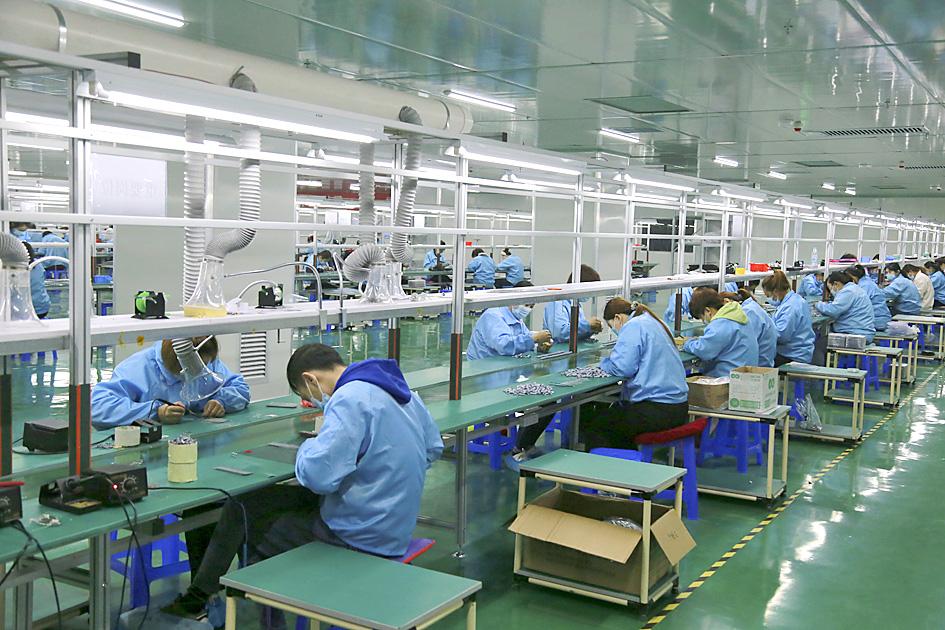Asia’s manufacturing activity remained robust through last month even as a gauge of factory output in China, the region’s top economy and industrial powerhouse, showed signs of cooling.
Taiwan’s IHS Markit manufacturing purchasing managers’ index (PMI) for last month rose to 62.4 from 60.8 in March, its highest reading since March 2010. New orders also reached their highest level since the same month.
South Korea’s IHS Markit PMI slipped to 54.6 from 55.3, but remains well above the 50 level, signaling ongoing expansion. It was the seventh straight month of expansion for the South Korean gauge, a first in almost a decade.

Photo: AP
Data on Saturday showed that South Korean exports last month rose the most in 10 years, reflecting a recovery from the effects of the COVID-19 pandemic and a boost from an increase in the number of working days from a year earlier.
Global trade has kept up its pandemic-era winning streak, with Asian economies especially benefiting from the boom in goods orders, the Bloomberg Trade Tracker shows. Shipments from South Korea and Taiwan have surged, buoyed by demand for electronics.
Supply crunches worldwide are resulting in a backup at some of the busiest ports, with inbound containers at the Port of Los Angeles notching a monthly gain in March that was more than eight standard deviations above its long-run average.
Annabel Fiddes, economics associate director at IHS Markit, said that supply-side crunches are beginning to dent Taiwan’s manufacturing boom as supplier delays hit a record.
“This is starting to weigh on overall production growth, while firms also registered a rapid increase in backlogs,” Fiddes said in a release. “Supply bottlenecks could weigh on performance in the months ahead, despite manufacturers’ efforts to build buffer stocks.”
India’s index inched up to 55.5 last month from 55.4 in March, even as a fresh wave of COVID-19 infections began to weigh on output and sales.
There also was robust growth in Southeast Asia. Indonesia’s PMI reading rose to 54.6 from 53.2, its highest since the series began and its sixth consecutive month of expansion. A subindex for new orders also ticked up.
Malaysia’s PMI rose to 53.9 from 49.9, also its highest reading since the series began. New orders rose and output jumped to 53.3 from 46.2 in March, its best level since June last year. The Philippines PMI fell to 49 from 52.2 — its lowest reading since October last year — reflecting ongoing restrictions to curb COVID-19.
The overall upbeat figures follow separate data released on Friday that showed China’s manufacturing expansion cooled last month. The official manufacturing PMI fell to 51.1 from 51.9 in the previous month.
Meanwhile, eurozone factory activity growth reached a record high last month, boosted by surging demand, driving a swell in hiring although supply side constraints led to an unprecedented rise in unfulfilled orders, a survey showed.
While a third wave of COVID-19 infections in Europe has forced some governments to shutter much of their dominant service industries, factories have largely remained open.
IHS Markit’s final manufacturing PMI rose to 62.9 from March’s 62.5, albeit below the initial 63.3 “flash” estimate, but the highest reading since the survey began in June 1997.
An index measuring output, which feeds into a composite PMI due tomorrow and that is seen as a good guide to economic health, edged down from March’s record high of 63.3 to 63.2. Anything above 50 indicates growth.
“Eurozone manufacturing is booming,” IHS Markit chief business economist Chris Williamson said.
“However, supply constraints are also running at unprecedented levels, leading to a record build-up of uncompleted orders at factories,” he added.
The backlogs of work index soared to 61.5 from 60.4, a survey high.
With the cost of raw materials rising at a near record pace, factories were forced to raise their own prices at the sharpest pace since IHS Markit began collecting the data.
“The big uncertainty is how long these upward price pressures will persist for, and the extent to which these higher charges for goods and services will feed through to consumers,” Williamson said.
Still, inflationary pressures might be welcomed by policymakers at the European Central Bank who have not managed to get inflation anywhere near their goal despite loose monetary policy.
Additional reporting by Reuters

Intel Corp chief executive officer Lip-Bu Tan (陳立武) is expected to meet with Taiwanese suppliers next month in conjunction with the opening of the Computex Taipei trade show, supply chain sources said on Monday. The visit, the first for Tan to Taiwan since assuming his new post last month, would be aimed at enhancing Intel’s ties with suppliers in Taiwan as he attempts to help turn around the struggling US chipmaker, the sources said. Tan is to hold a banquet to celebrate Intel’s 40-year presence in Taiwan before Computex opens on May 20 and invite dozens of Taiwanese suppliers to exchange views

Application-specific integrated circuit designer Faraday Technology Corp (智原) yesterday said that although revenue this quarter would decline 30 percent from last quarter, it retained its full-year forecast of revenue growth of 100 percent. The company attributed the quarterly drop to a slowdown in customers’ production of chips using Faraday’s advanced packaging technology. The company is still confident about its revenue growth this year, given its strong “design-win” — or the projects it won to help customers design their chips, Faraday president Steve Wang (王國雍) told an online earnings conference. “The design-win this year is better than we expected. We believe we will win

Quanta Computer Inc (廣達) chairman Barry Lam (林百里) is expected to share his views about the artificial intelligence (AI) industry’s prospects during his speech at the company’s 37th anniversary ceremony, as AI servers have become a new growth engine for the equipment manufacturing service provider. Lam’s speech is much anticipated, as Quanta has risen as one of the world’s major AI server suppliers. The company reported a 30 percent year-on-year growth in consolidated revenue to NT$1.41 trillion (US$43.35 billion) last year, thanks to fast-growing demand for servers, especially those with AI capabilities. The company told investors in November last year that

Power supply and electronic components maker Delta Electronics Inc (台達電) yesterday said it plans to ship its new 1 megawatt charging systems for electric trucks and buses in the first half of next year at the earliest. The new charging piles, which deliver up to 1 megawatt of charging power, are designed for heavy-duty electric vehicles, and support a maximum current of 1,500 amperes and output of 1,250 volts, Delta said in a news release. “If everything goes smoothly, we could begin shipping those new charging systems as early as in the first half of next year,” a company official said. The new